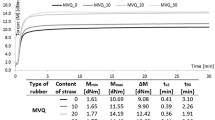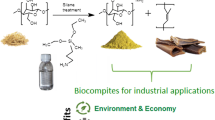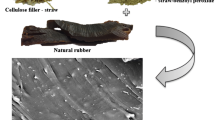Abstract
The purpose of the work is to prepare and characterize hybrid fillers of cereal straw - perlite as well as to examine their impact on the functional properties of elastomeric biocomposites. Natural rubber was used as the polymer matrix, vulcanized with a sulfuric crosslinking system. The subject matter of the work included an interdisciplinary knowledge segment in the field of polymertechnology - hybrid biomaterials. The work investigated the effect of physical (mechanical) modification of lignocellulosic filler. The process of milling and homogenization of cereal straw with the addition of perlite was carried out in a planetary ball mill. The properties of biocomposites were examined in terms of two key aspects: The amount of hybrid filler and its ratio (cereal straw to natural mineral). The plate-like structure of natural minerals and the fibrous structure of cereal straw created a two-component filler, which influenced the properties of the produced biomaterials. A significant improvement in barrier, crosslinking density, hardness, mechanical and damping properties has been noted for systems containing hybrid fillers. Moreover, all vulcanizates proved to be resistant to the rmooxidative aging. Furthermore, the straw modificated with perlite formed a more complex structure in the composites, resulting in a stronger reinforcing effect, which was confirmed by dynamic-mechanical analysis (Payne effect).
Similar content being viewed by others
References
Majeed K, Hassan A, Abu Bakar A. Barrier, biodegradation, and mechanical properties of (Rice husk)/(Montmorillonite) hybrid filler-filled low-density polyethylene nanocomposite films. Journal of Vinyl and Additive Technology, 2017, 23, 162–171.
Faruk O, Bledzki A K, Fink H P, Sain M. Biocomposites reinforced with natural fibers: 2000–2010. Progress in Polymer Science, 2012, 37, 1552–1596.
Balla V K, Kate K H, Satyavolu J, Singh P, Tadimeti J G D. Additive manufacturing of natural fiber reinforced polymer composites: Processing and prospects. Composites Part B: Engineering, 2019, 174, 106956.
Faruk O, Ain M S. Biofiber reinforced polymer composites for structural applications. Developments in Fibre-Reinforced Polymer Composites for Civil Engineering, 2013, 2, 18–53.
Mohanty A K, Misra M, Hinrichsen G. Biofibres, biodegradable polymers and biocomposites: An overview. Macromolecular Materials and Engineering, 2000, 276, 1–24.
Joshi S V, Drzal L T, Mohanty A K, Arora S. Are natural fiber composites environmentally superior to glass fiber reinforced composites? Composites Part A: Applied Science and Manufacturing, 2014, 35, 371–376.
Al-Maadeed M A, Labidi S. Recycled polymers in natural fibre-reinforced polymer composites. Natural Fibre Composites: Materials, Processes and Properties, 2013, 4, 103–114.
Mohanty A K, Misra M, Drzal L T. Sustainable bio-composites from renewable resources: Opportunities and challenges in the green materials world. Journal of Polymers and the Environment, 2002, 10, 19–26.
Dicker M P M, Duckworth P F, Baker A B, Francois G, Hazzard M K, Weaver P M. Green composites: A review of material attributes and complementary applications. Composites Part A: Applied Science and Manufacturing, 2014, 56, 280–289.
Eichhorn S J, Baillie C A, Zafeiropoulos N, Mwaikambo L Y, Ansell M P, Dufresne A, Entwistle K M, Herrera-Franco P, Canché-Escamilla G, Groom L H, Hughes M, Hill C A S, Rials T, Wild P M. Current international research into cellulosic fibres and composites. Journal of Materials Science, 2001, 36, 2107–2131.
Koronis G, Silva A, Fontul M. Green composites: A review of adequate materials for automotive applications. Composites Part B: Engineering, 2013, 44, 120–127.
Summerscales J, AmandeepS. Virk, Hall W, Dissanayake NPJ. A review of bast fibers and their composites. Part 1-Fibers as reinforcements. Composites Part A: Applied Science and Manufacturing, 2010, 41, 1329–1335.
Zini E, Scandola M. Green composites: An overview. Polymer Composites, 2011, 321905–321915.
Panthapulakkal S, Sain M. The use of wheat straw fibres as reinforcements in composites. Biofiber Reinforcements in Composite Materials, 2014, 14, 423–453.
Majeed K, Jawaid M, Hassan A, Abu Bakar A, Abdul Khalil H P S, Salema A A, Inuwa I M. Potential materials for food packaging from nanoclay/natural fibres filled hybrid composites. Materials & Design, 2013, 46, 391–410.
Zainudin E S, Yan L H, Haniffah W H, Jawaid M, Alothman O Y. Effect of coir fiber loading on mechanical and morphological properties of oil palm fibers reinforced polypropylene composites. Polymer Composites, 2014, 35, 1418–1425.
Essabir H, Boujmal R, Bensalah M O, Rodrigue D, Bouhfid R, Qaiss A E K. Mechanical and thermal properties of hybrid composites: Oil-palm fiber/clay reinforced high density polyethylene. Mechanics of Materials, 2016, 98, 36–43.
Baheti V, Abbasi R, Militky J. Ball milling of jute fibre wastes to prepare nanocellulose. World Journal of Engineering, 2012, 9, 45–50.
Hajiha H, Sain M. The use of sugarcane bagasse fibres as reinforcements in composites. Biofiber Reinforcements in Composite Materials, 2015, 17, 525–549.
Arifuzzaman M, Kim H S. Novel mechanical behaviour of perlite/sodium silicate composites. Construction and Building Materials, 2015, 93, 230–240.
Oktay H, Yumrutaş R, Akpolat A. Mechanical and thermophysical properties of lightweight aggregate concretes. Construction and Building Materials, 2015, 96, 217–225.
Celik S, Family R, Menguc M P. Analysis of perlite and pumice based building insulation materials. Journal of Building Engineering, 2016, 6, 105–111.
Maaloufa Y, Mounir S, Khabbazi A, Kettar J, Khaldoun A. Thermal characterization of materials based on clay and granular: Cork or expanded perlite. Energy Procedia, 2015, 74, 1150–1161.
Halimi Y H. Development and characterization of a composite material reinforced by plastic waste: Application in the construction sector. International Journal of GEOMATE, 2017, 13, 172–178.
Mattausch H, Laske S, Cirar K, Flachberger H, Holzer C. Influence of processing conditions on the morphology of expanded perlite/polypropylene composites. AIP Conference Proceedings, 2014, 1593, 482–486.
Kaczmarek H, Chylihska M, Klimiec E, Królikowski B, Sionkowski G, Machnik M. Piezo-electrets from polypropylene composites doped with mineral fillers. Pure and Applied Chemistry, 2019, 91, 967–982.
Pinto J R A, Sanches N B, Diniz M F, Santos R S, De Oliveira J I S, Dutra R D C L. Expanded perlite/cork fillers applied to aerospace insulation material. Anais da Academia Brasileira de Ciências, 2018, 90, 3197–3206.
Sokołowska J J, Woyciechowski P P, Łukowski P, Kida K. Effect of perlite waste powder on chemical resistance of polymer concrete composites. Advanced Materials Research, 2015, 1129, 516–522.
Li T T, Chuang Y C, Huang C H, Lou C W, Lin J H. Applying vermiculite and perlite fillers to sound-absorbing/thermal-insulating resilient PU foam composites. Fibers and Polymers, 2015, 16, 691–698.
Bulut M, Erklig A, Dogan N F. On adhesive properties of perlite and sewage sludge ash with epoxy resin bonded single-strap repairs. Materials Research Express, 2017, 4, 85302.
Masłowski M, Miedzianowska J, Strzelec K. Natural rubber biocomposites containing corn, barley and wheat straw. Polymer Testing, 2017, 63, 84–91.
Masłowski M, Miedzianowska J, Strąkowska A, Strzelec K, Szynkowska M I. The use of rye, oat and triticale straw as fillers of natural rubber composites. Polymer Bulletin, 2018, 75, 4607–4626.
Masłowski M, Miedzianowska J, Strzelec K. Silanized cereal straw as a novel, functional filler of natural rubber biocomposites. Cellulose, 2019, 26, 1025–1040.
Masłowski M, Miedzianowska J, Strzelec K. Natural rubber composites filled with cereals straw modified with acetic and maleic anhydride: Preparation and properties. Journal of Polymers and the Environment, 2018, 26, 4141–4157.
Miedzianowska J, Masłowski M, Strzelec K. Thermoplastic elastomer biocomposites filled with cereal straw fibers obtained with different processing methods-Preparation and properties. Polymers, 2019, 11, 641.
Masłowski M, Miedzianowska J, Strzelec K. Natural rubber composites filled with crop residues as an alternative to vulcanizates with common fillers. Polymers, 2019, 11, 972.
Flory P J, Rehner J. Statistical mechanics of cross-Linked polymer networks I. Rubberlike elasticity. The Journal of Chemical Physics, 1943, 11, 512–520.
Roovers J, Toporowski P M. Characteristic ratio and plateau modulus of 1,2-polybutadiene. A comparison with other rubbers. Rubber Chemistry and Technology, 1990, 63, 734–746.
Ahmed K, Nizami S S, Raza N Z, Habib F. The effect of silica on the properties of marble sludge filled hybrid natural rubber composites. Journal of King Saud University, 2013, 25, 331–339.
Masek A, Zaborski M, Kosmalska A, Chrzescijanska E. Eco-friendly elastomeric composites containing Sencha and Gun Powder green tea extracts. Comptes Rendus Chimie, 2012, 15, 331–335.
Strąkowska A, Kosmalska A, Masłowski M, Szmechtyk T, Strzelec K, Zaborski M. POSS as promoters of self-healing process in silicone composites. Polymer Bulletin, 2018, 76, 3387–3402.
Summerell B A, Burgess LW. Decomposition and chemical composition of cereal straw. Soil Biology and Biochemistry, 1989, 21, 551–559.
Abdullah S, Yusup S, Ahmad M, Ramli A, Ismail L, Preparation A S. Thermogravimetry study on pyrolysis of various lignocellulosic biomass for potential hydrogen production. World Academy of Science, Engineering and Technology, 2010, 72, 129–133.
Wyasu G, Gimba C E, Agbaji E B, Ndukwe G I. Thermo-gravimetry(TGA) and DSC of thermal analysis techniques in production of active carbon from lignocellulosic materials. Advances in Applied Science Research, 2016, 7, 109–115.
Pichór W, Janiec A. Thermal stability of expanded perlite modified by mullite. Ceramics International, 2009, 35, 527–530.
Payne A R. The dynamic properties of carbon black loaded natural rubber vulcanizates. Journal of Applied Polymer Science, 1962, 6, 368–372.
Payne A R, Whittaker R E. Low strain dynamic properties of filled rubbers. Rubber Rubber Chemistry and Technology, 1971, 44, 440–478.
Acknowledgment
This work was supported by the National Science Centre, Poland (PRELUDIUM no. 2018/31/N/ST8/00802).
Author information
Authors and Affiliations
Corresponding author
Rights and permissions
About this article
Cite this article
Masłowski, M., Miedzianowska, J. & Strzelec, K. Hybrid Straw/Perlite Reinforced Natural Rubber Biocomposites. J Bionic Eng 16, 1127–1142 (2019). https://doi.org/10.1007/s42235-019-0124-2
Published:
Issue Date:
DOI: https://doi.org/10.1007/s42235-019-0124-2




